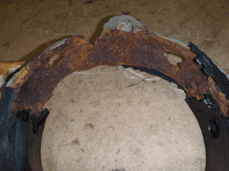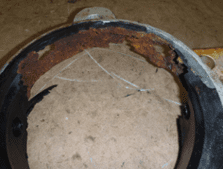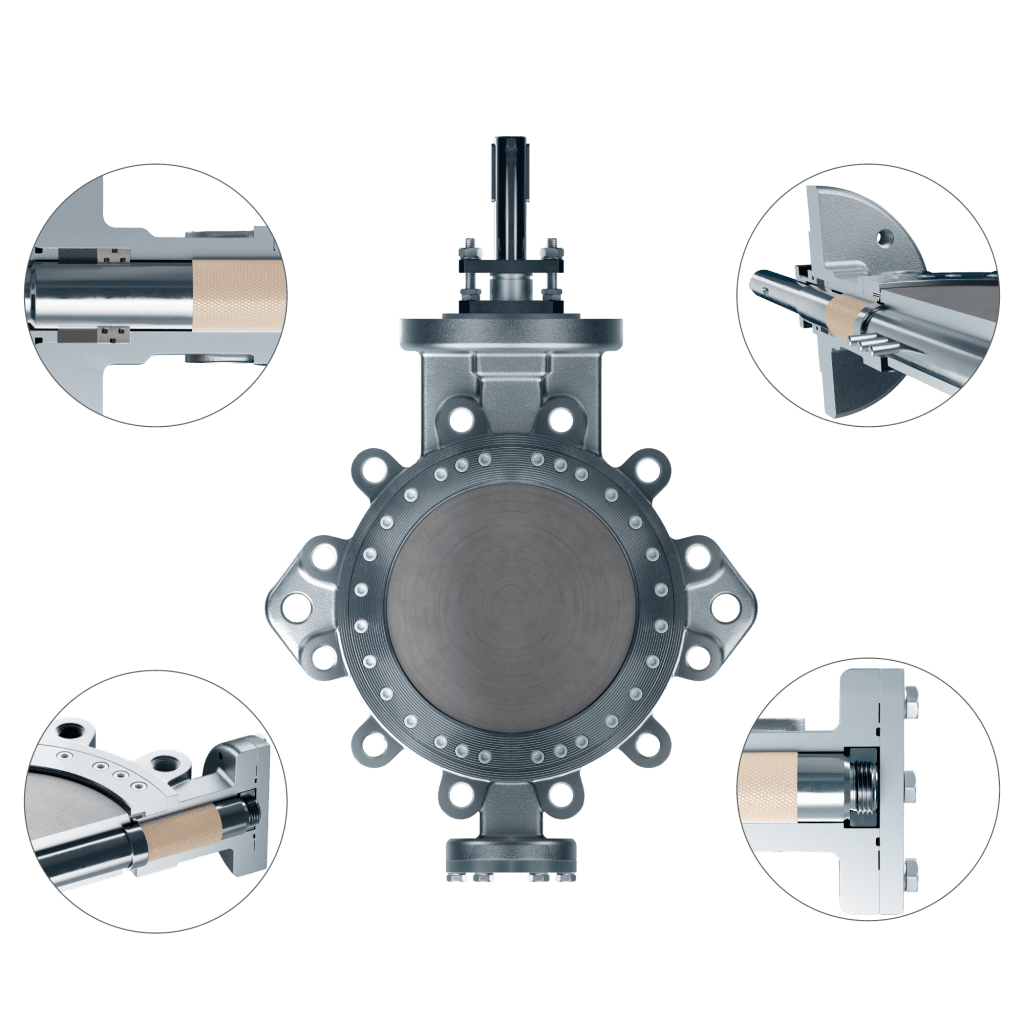Butterfly Valves in Fire Water Systems – Tackling Galvanic Corrosion
Posted: 17 November 2025A Technical Overview of Design, Safety, and Corrosion Considerations In Fire Water Systems
Galvanic Corrosion: The hidden risk that provides costly challenges for operators
Thankfully strict safety protocols have been put in place by operators, meaning the greatest problem for these valves is failure due to corrosion rather than through heat. An increasing number of assets are seeing the failure of these critical valves after a few years. Up to now the solution has been to replace the valve like for like and implement a maintenance schedule as part of the planned TAR’s. This is not only inefficient but can be expensive. But, with the graphite isolated solution of Severn’s OCT-SW valve, there is now a superior solution.



What is Galvanic Corrosion?
It occurs when two dissimilar metals are in electrical contact in the presence of an electrolyte (e.g., seawater). The more active (less noble) metal corrodes preferentially.
- Graphite: Highly noble and acts as a cathode.
- Metallic Valve Components: Act as the anode and corrode.
- Result: Accelerated degradation of valve components, especially at sealing interfaces.
Nobility of materials
The term “nobility” of materials refers to a material’s resistance to corrosion, oxidation, and other forms of chemical degradation. Noble materials, like gold and platinum, are highly unreactive and do not easily combine with other elements. Conversely, “active” or “base” materials, such as iron and zinc, are more reactive and prone to corrosion.
Galvanism can be traced back to the 18th century when physician Luigi Galvani discovered that an electrical current could be created from a chemical reaction. His research laid the groundwork for the study of chemical electricity, or “galvanism”.
Following Galvani’s work, Alessandro Volta invented the first battery by stacking discs of two different metals separated by a salt-soaked material. This demonstrated that a sustained electric current could be created from the chemical interaction between dissimilar metals in an electrolyte. Scientists soon made the link and established this phenomenon to corrosion. They discovered that when two dissimilar metals were in electrical contact and exposed to an electrolyte (like saltwater), one metal would corrode more quickly than it normally would, while the other would be protected.
The modern scientific concept of nobility is derived from centuries of practical human experience with different metals.
The Galvanic Series
- Ranking by potential: The empirical observation of this galvanic effect led to the development of the galvanic series (or electro potential series). In this series, materials are ranked from “active” (most reactive and prone to corrosion) to “noble” (least reactive and most resistant to corrosion).
- Electrode potential: This ranking is based on a material’s electrode potential, which is a measure of its tendency to gain or lose electrons. More active metals have a lower (more negative) potential, while noble metals have a higher (more positive) potential.
Today, engineers and scientists use the galvanic series to predict how different materials will interact in a corrosive environment. By understanding how this process works. Appropriate materials can be selected or ideally removed to stop the galvanic corrosion happening.
The Issue With Valves….
The use of graphite as a sealing mechanism is widespread across numerous industries due to its excellent sealing properties, chemical resistance, and ability to withstand extreme temperatures. However, in marine environments, particularly when exposed to seawater, its highly noble (cathodic) nature poses a significant risk of galvanic corrosion to the less noble (anodic) metallic components it contacts. This phenomenon is a major concern for offshore and maritime operators, as it can lead to compromised seal integrity, costly equipment damage, and unplanned downtime.
In a seawater-exposed assembly, a metallic component—for instance, a stainless-steel flange or valve stem—acts as the anode. The adjacent graphite gasket or packing acts as the cathode. The seawater completes the electrical circuit, drawing electrons from the less noble metal (the anode) and transferring them to the more noble graphite (the cathode). This leads to an accelerated dissolution of the anodic metal, concentrating the corrosion damage at or near the seal interface.
A particular concern is the combination of graphite with stainless steels. While austenitic stainless steels (e.g., 316L) are generally more resistant to corrosion, they are not immune. Some industry standards, such as NORSOK, even prohibit the use of graphite in sealing materials for offshore applications to eliminate this corrosion risk. Material selection is critical for valves on this duty. By utilising materials like Super Duplex or Aluminium Bronze, using hard facing on critical sealing faces and hard wearing seal materials, Service life for this critical application can be significantly increased.
Engineering Out Corrosion
The most definitive solution to prevent galvanic corrosion is to remove the graphite seal and replace it with a non-conductive alternative. Recent developments in sealing technology have introduced advanced materials specifically designed for demanding seawater applications where galvanic corrosion is a risk.
Modern valve designs, such as the Oblique Cone Technology (OCT-SW) Triple Offset Butterfly Valve, have been engineered to ensure graphite parts do not come into contact with the seawater, effectively isolating the corrosive elements from the line media and have solved this issue with patented and advanced Butterfly valve technology. The shift toward graphite-isolated technologies represents the most robust and sustainable solution for ensuring safety, extending equipment life, and reducing maintenance costs in demanding and safety critical seawater applications.

Initial Investment vs overall cost of ownership
It’s often a false economy with the old saying that “buy cheap, buy twice” but the cost and implications of buying cheap can be much worse. Greenfield sites can often be driven very much on cost, with the priority of building the new platform or vessel being that if it meets specification, lets buy the cheapest. But is the specification right and is the most cost effective to buy, the most cost effective overall?
Wrongly specified valves can often fail prematurely due to poor material selection or even be designed as throwaway items designed to last until the next TAR or service interval. But what happens if they don’t last and fail prematurely? What is the true cost unplanned downtime of replacing the valve on a critical safety system such as a fire water line.
Worst case scenario is that operations must stop, if it’s not safe to operate, production can be halted resulting in $millions in lost production until the valve can be replaced. If it’s deemed that it’s safe to operate, but the valve must be replaced urgently, mobilising costs, replacement valves, and the logistics of shipping valves offshore can run into hundreds of thousands of dollars.
All these costs and risks can be mitigated, by investing in the best solution initially, or for existing plants to upgrade to a better solution. By selecting a valve that’s been designed specifically for the application and materials that have been optimised for the media, unplanned downtime can be a thing of the past.
Severn’s OCT valve has been designed to be repaired and not replaced. The highest cost of the valve is often the main components such as the body and disc, often the best material for seawater service is exotic materials such as Super Duplex, Aluminium Bronze or can even extend to Hastelloy’s and Titanium for more severe applications where issues are known. By protecting the critical sealing surfaces by hard facing, it means that when the valves do need to be serviced, it can be done by replacing soft goods only, not just once, but time after time.
The engineered design of the OCT-SW means that valves can be overhauled on site with only basic tools, valves can be removed from line, overhauled and re-installed within hours. By repairing the valve, it also reduces waste and helps the operators meet ESG targets. It also further reduces costs associated with waste management and shipping waste back onshore. In summary, investing in the correct and most appropriate solution from the outset, may cost a little more that the “off the Shelf one size fits all” solution, but the overall savings could be millions.
Conclusion
Firewater systems are mission-critical safety assets. Every component must perform under extreme conditions—especially Isolation valves. Specifying fire-safe certified and corrosion-resistant valves is essential for:
- Personnel Safety
- Asset Protection
- Regulatory Compliance
- Operational Continuity
- Reduced Downtime
- Managing Environmental Risks
Severn Glocon’s OCT-SW valve exemplifies how advanced engineering can deliver robust, long-term solutions for offshore & coastal facility firewater systems. This solution can not only significantly reduce the overall cost on ownership and increase service life, but more importantly increase plant safety and reduce risk.
More News
All News- Posted: 17 November 2025 Butterfly Valves in Fire Water Systems
- Posted: 15 October 2025 Severn TrimGuard – Advancing Impact Resistance in Choke Valves
- Posted: 21 July 2025 LNG’s Ultimate Line of Defence
- Posted: 21 July 2025 The Critical Role of Valve Spares in Effective LNG Control
- Posted: 14 July 2025 Severn’s Anti-Surge Valves Satisfy Rigours of Dynamic Testing, Without Concession
- Posted: 7 July 2025 LNG compressor problems? Safety, efficiency, performance, and reliability issues are often due to poor Anti-Surge Valve Control


